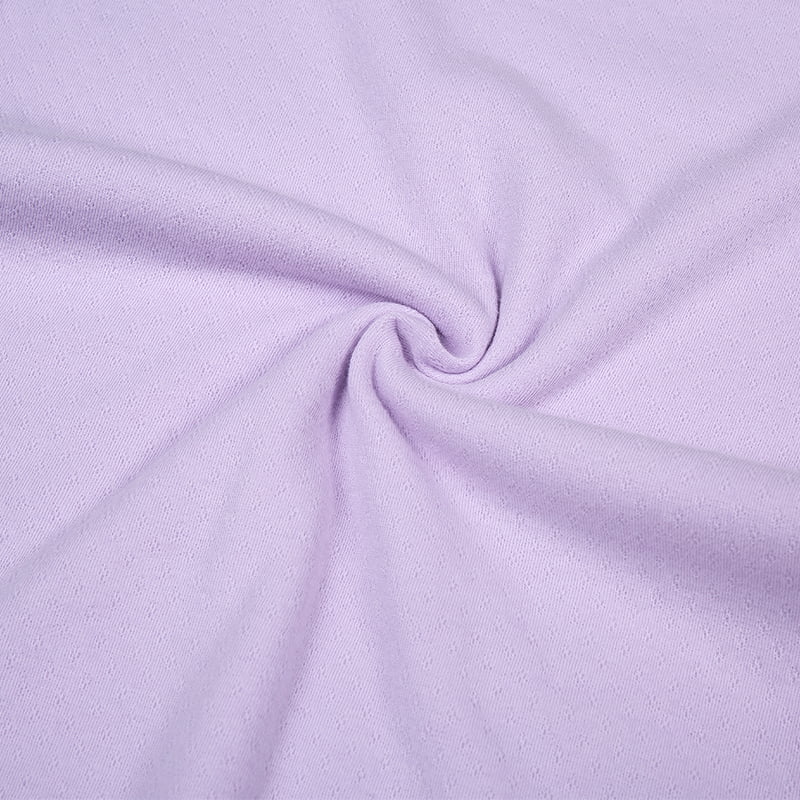
The gauge of the knitting machine plays a critical role in determining the texture, density, and overall characteristics of ribbed jacquard knitted fabric. Here’s an in-depth look at how gauge influences these aspects:
Definition and Significance of Gauge
Gauge: The gauge of a knitting machine refers to the number of needles per inch on the knitting bed or cylinder. It dictates how tightly or loosely the fabric is knitted, influencing the number of stitches per inch.
Importance: Gauge determines the fabric’s texture, density, appearance, and functional properties.
Impact on Texture
Fine Gauge (High Gauge)
Characteristics: A high gauge, such as 18 or more needles per inch, produces finer, smoother fabrics with a higher stitch count per inch.
Effect on Texture: Results in a more delicate, detailed texture, allowing for intricate jacquard patterns and a refined appearance. The ribbing in ribbed jacquard will be more subtle and compact.
Applications: Ideal for lightweight garments, detailed patterns, and applications requiring fine, soft textures.
Coarse Gauge (Low Gauge)
Characteristics: A low gauge, such as 8 or fewer needles per inch, produces thicker, coarser fabrics with a lower stitch count per inch.
Effect on Texture: Leads to a more pronounced, bulkier texture with more prominent ribbing. The fabric is generally chunkier and less refined, which can enhance the tactile quality and create more noticeable jacquard patterns.
Applications: Suitable for heavy-duty fabrics, outerwear, and applications where a rugged texture or bold patterns are desired.
Impact on Density
High Density in Fine Gauge Fabrics
Fabric Structure: High gauge fabrics have a greater number of stitches per inch, resulting in a dense and compact structure.
Effect on Density: The increased density enhances the fabric’s durability and resilience, making it less prone to snagging or pilling. It also affects the fabric’s drape, making it more stable and less prone to stretching.
Impact on Ribbing: The ribs will be closely spaced and less prominent, contributing to a smoother surface that can support detailed jacquard designs.
Low Density in Coarse Gauge Fabrics
Fabric Structure: Low gauge fabrics have fewer stitches per inch, leading to a looser, more open structure.
Effect on Density: This reduces the fabric's overall density, making it softer and more flexible, but also potentially less durable and more prone to distortion over time.
Impact on Ribbing: The ribs will be more spaced out and prominent, giving the fabric a more textured feel and a more noticeable ribbed appearance. The jacquard patterns may appear less detailed but more pronounced.

Impact on Functional Properties
Elasticity and Recovery
Fine Gauge: The tight knitting in high gauge fabrics provides controlled stretch and recovery, leading to excellent shape retention and elasticity, making them ideal for form-fitting garments.
Coarse Gauge: Low gauge fabrics are typically stretchier and more forgiving, but may not retain their shape as well, suitable for relaxed-fit clothing and items that require more give.
Breathability and Insulation
Fine Gauge: Higher density in fine gauge fabrics can make them less breathable but better at trapping warmth, making them suitable for cooler weather or indoor applications.
Coarse Gauge: The looser structure of low gauge fabrics allows for better air circulation, making them more breathable and suitable for warmer climates or outdoor wear.
Impact on Pattern and Design
Pattern Definition
Fine Gauge: The high stitch density allows for more detailed and intricate jacquard patterns, with clearer, crisper edges and complex designs.
Coarse Gauge: Patterns may be less detailed and have a chunkier appearance, with more emphasis on bold, simple designs and pronounced textures.
Pattern Versatility
Fine Gauge: Suitable for sophisticated and intricate designs that require fine detailing, such as logos, intricate motifs, and fine ribbing.
Coarse Gauge: Ideal for larger, bolder patterns and designs where texture is a key feature, such as cable knits and wide ribbing.
Impact on Fabric Use and End-Product
Fine Gauge Fabrics
Usage: Ideal for lightweight garments, detailed fashion items, and applications where a smooth, fine texture is essential.
End-Product: Often used in upscale fashion, lingerie, and finely detailed knitwear.
Coarse Gauge Fabrics
Usage: Best for heavy-duty garments, casual wear, and applications requiring a more substantial, textured fabric.
End-Product: Commonly used in winter wear, casual knitwear, and items where bold textures and patterns are desired.
The gauge of the knitting machine fundamentally shapes the texture, density, and functionality of ribbed jacquard knitted fabrics. Fine gauges produce smooth, dense fabrics with detailed patterns, while coarse gauges create thicker, textured fabrics with pronounced ribs and bold designs. This knowledge is crucial for selecting the right gauge for specific applications and achieving the desired fabric properties.


 English
English 中文简体
中文简体











